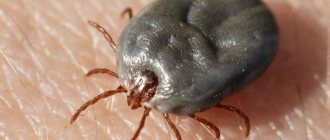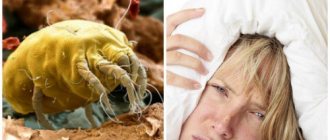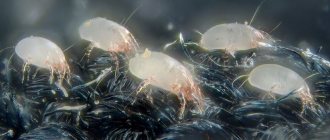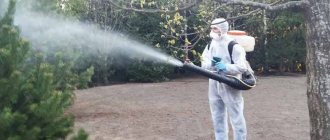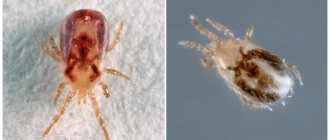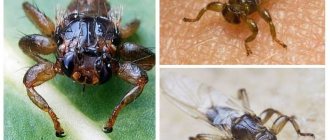House dust mite
The most important role in the development, maintenance and provocation of exacerbations of allergic diseases belongs to household allergens, and especially house dust.
But house dust
is heterogeneous and contains many components:
- various fibers,
- pieces of epidermis (upper layers of skin) of humans and animals,
- spores of mold and yeast fungi,
- cockroach allergens and their metabolic products, etc.,
- as well as microscopic mites and their metabolic products.
| House dust mites are one of the most important allergens. It lives in every house all year round, but periodically its numbers increase sharply. This is the most common household allergen and is a risk factor for allergic diseases. Science has established that reducing contact with an allergen improves the course of these diseases, so they began to study mites and develop measures aimed at reducing the number of mites and their allergens in houses and apartments. |
Treatment of allergies from bed mites
Everyone knows that linen mite bites cause an allergic reaction in many people. Before prescribing treatment for an allergy to white mite dust, skin tests should be performed to accurately determine the presence of insects and help determine the causes of infection. Modern medicine offers a wide range of anti-allergenic drugs that can be used in this situation. Unfortunately, they will not completely eliminate allergies, but during treatment they will help eliminate symptoms and significantly improve the patient’s quality of life. Among the medications, the most commonly used are:
- Telfast.
- Erius.
- Aquamaris.
- Cetirizine.
In addition to these remedies, other antihistamines and corticosteroid medications will also help get rid of allergies. It is possible to prescribe hyposensitization - a procedure in which allergens are introduced in small doses, forcing the body to get used to their presence. Since tick bites on the body cause redness and severe itching, you also need to know what to use against tick bites and what creams and ointments are suitable for this. In this case, in parallel with oral medications, it is recommended to lubricate the bite sites with local agents that eliminate allergy symptoms.
Use of folk remedies
Dust mite bites can also be treated using traditional medicine. Folk remedies help eliminate their symptoms on human skin and significantly reduce the manifestations of allergies. Body mites quickly attack the body with a weakened immune system, so to strengthen it, traditional medicine recommends using such remedies as propolis tincture, lemon juice, goat milk, which can also treat any type of allergic reaction. You can also get rid of the symptoms of an allergy to house mites by using a saline solution, which is used to rinse your nose, this makes it possible to wash out the allergens from the sinuses.
The most important thing about the tick
Preparations to combat bed mites
A good option for eliminating parasites is winter with severe frosts. In this case, you can take pillows, blankets and other similar items related to the bed out into the cold for several hours. Summer “roasting” in direct sunlight is no less successful. But special insecto-acaricidal preparations will help completely destroy the population of bed mites.
The drugs help cope with various kinds of parasites in several applications. Their protection against pests of this type lasts up to 1.5 months. When the bed mite is eliminated, it is easier to carry out the usual prevention in the form of the previously mentioned tips.
How do you know if you are allergic to house dust mites?
This type of allergy can be suspected if the condition clearly worsens upon contact with house dust (for example, when making the bed, sweeping the floor, knocking out carpets or removing curtains), if the periods of deterioration coincide with the periods of active mite reproduction, if it becomes bad in rooms where there are a lot of carpets and objects that accumulate dust (including animal skins, soft toys, heavy curtains, etc.). Manifestations can be different:
allergic rhinitis, most often year-round, allergic conjunctivitis, atopic dermatitis/eczema, bronchial asthma. Those. manifestations depend on which organ reacts more: skin, mucous membranes of the eyes, nose or bronchi. To clarify the diagnosis, you should contact an allergist and undergo an allergological examination, which includes skin tests and an analysis for the presence of antibodies to a given allergen in the blood (RAST - radioallergosorbent test - or other methods).
How do you know if there are a lot of ticks and their allergens in your home?
There are test systems that allow you to conduct your own assessment.
In addition, there are organizations that carry out environmental inspections of premises. For example, the Research Institute of Vaccines and Serums named after I.I. Mechnikov. What can you change in your home to make conditions more suitable for you and less suitable for ticks?
First of all, you should reduce the number of places where dust accumulates
. There should be no fur skins, carpets, canopies, or curtains. If possible, it is advisable to replace furniture with fabric upholstery with leather, and curtains with blinds or curtains that can be easily washed in hot water. Things of simple design are desirable: various decorative details serve as places where ticks accumulate. Items that collect dust should be stored in closed cupboards, books on glass shelves. Children should not take stuffed toys to bed. Pets should not be allowed into the bedroom or bed, even if you are not allergic to them.
You can reduce air dust and the amount of aeroallergens by regulating humidity and using air purifiers with HEPA filters. Some authors recommend quartzing the bedroom for 15-30 minutes before going to bed (in the absence of people and with the obligatory use of an air purifier).
As already mentioned, ticks prefer heat and high humidity. At the same time, at very low humidity, dust is suspended in the air and does not settle for hours. In addition, low humidity causes discomfort, fatigue, dry skin and mucous membranes. Therefore, wet cleaning and controlled humidification are necessary, especially during the heating season. The humidity level for tick allergies should be 40-50%.
Bedding is very important
. Down and feather pillows and mattresses, wool and cotton blankets should be replaced with synthetic ones (polyester, lyocell, Thinsulate), with high airiness and maintaining a humidity regime. It is acceptable to use “protected” natural fillers with the “NOMITE” mark (a trademark that is a certificate of suitability of the product for people with allergies to house dust mites).
How often to wash bedding
Bedding should be washed 1-2 times a week either in hot water with a temperature above 55-60C, or with special additives (see substances that directly act on ticks).
Bedding also needs to be washed frequently. Allergists recommend very frequent washing - from 1 time a week (GINA-2002) to 1 time a month (Guidelines of the I.I. Mechnikov Research Institute of Vaccines and Serums). At the same time, most manufacturers recommend washing their products 2-3 times a year or simply indicate that frequent machine washing is possible. The solution may be to use special anti-allergenic or acaricidal additives for washing (from the Easy Air series), eliminating mites and their allergens, and, of course, using special covers (see below). This allows you to wash bedding less often. When “freezing out” a tick or ventilating it in bright sun, the exposure period should exceed 3 hours.
How to (literally) provide a barrier to a tick?
The best protection for bedding is provided by protective covers made of special densely woven fabric.
There are different levels of such protection: there are fabrics through the fibers of which an adult tick cannot penetrate. Of course, in this case, it is imperative to pre-treat the pillow, blanket or mattress that will be protected by such fabric from ticks and their allergens. This is the fabric used in pillows and blankets with the “NOMITE” sign. There is also a higher level: when the fabric is so dense that it is impenetrable to both ticks and its allergens (but permeable to air and water, so that a person feels comfortable and does not sweat). Covers of this type can help not only with tick allergies, as they reduce contact with other allergens. An example of such covers is (covers made of non-woven material with HEPA filter properties, service life 2 years). In addition, covers have been developed from fabric so dense that it, while remaining permeable to air and water, is capable of trapping smaller allergens than mite allergens; its degree of protection is maximum. Such covers are quite expensive, but very effective and last a long time: up to 5 years.
Bed mites: how to get rid of this disease?
During the day, are you constantly plagued by annoying itching, your skin is covered in red spots, and your once favorite sofa has turned into a torture chamber?
Congratulations: you have a large number of mites in your bed.
More precisely, we sympathize. Still, this is a big nuisance - bed mites. How to get rid of them?
The average size of a house dust mite is 0.2 mm. Bed ticks are so small that you won't be able to see them. They have three pairs of legs.
There are suction cups on the legs, making it almost impossible to remove live ticks in the sofa with a vacuum cleaner.
Their protective, waxy, water-repellent layer allows them to literally run on water and even pass through water droplets.
Only in combination with soap can water destroy this property.
Bed ticks are afraid of light and hide in the dust. They find their main source of nutrition in skin dandruff, which a person loses per day in the amount of 1.5 grams.
Ticks in the sofa prefer a humid-warm climate (20-25°C with an air humidity of 60-80%).
Therefore, they find the atmosphere they need mainly in the sleeping quarters. The permissible limit for mites in a sofa or in the atmosphere is 100 mites per 1 gram of dust.
When this level increases, even a healthy person may experience an allergy.
So, you have diagnosed: bed mites have settled in you after all. How to get rid of this trouble?
Experts advise ventilating more often, as well as freezing or warming bed linen, pillows, blankets and mattresses.
However, this is not always effective.
To combat bed mites, you can also change pillows, feather beds and duvets every five years. But good housewives know how expensive it is.
Another option to combat bed mites: wash the down and feathers in pillows and blankets to prolong their life and protect yourself from exposure to harmful mites.
Such services are relatively inexpensively provided by dry cleaners.
Thus, bed mites can cost a pretty penny. How to get rid of them without hurting your pocket? There is one way.
The feathers from the pillow should be carefully transferred to a bag made of loose fabric and dipped into a warm soapy solution, adding ammonia or borax to it.
For a bucket of water you need to take 50 g of soap and half a glass of ammonia or a teaspoon of borax (or boric acid).
The bag of feathers is immersed in the solution and left in it for two to three hours, turning it over and soaking it several times during this time.
Then the bag is removed and rinsed in clean water 3-4 times. Then it is wrung out and air dried, hanging on a rope.
To prevent the feathers from matting during drying, knead the stuck together lumps in the bag several times.
Well-dried feathers or down are carefully transferred to a new “napernik”, that is, a primary pillowcase made of a special fabric called “teak”.
As a last resort, you can take another material, which must be rubbed from the inside out with wax or soap, and then ironed through a rag.
The film formed on the pillowcase does not allow down and feathers to pass through the fabric.
If you find a bed tick in your apartment, you need treatment.
Scabies is an unpleasant consequence that bed mites have on humans. Treatment most often involves rubbing anti-scabies into the skin, especially carefully into the mite’s favorite localization areas.
Before starting treatment, it is advisable to take a hot shower, using a washcloth and soap, to mechanically remove mites from the surface of the skin, as well as to loosen the surface layer of the epidermis, which facilitates the penetration of antiparasitic agents.
In the presence of secondary pyoderma, water procedures are contraindicated. During treatment, washing is prohibited.
After each forced hand washing, it is necessary to re-treat them with an anti-scabies agent.
If your health has been damaged by a bed tick, treatment may consist of using a water-soap emulsion of benzyl benzoate (20% for adults and 10% for children).
The emulsion is shaken and thoroughly rubbed into the skin with a cotton-gauze swab 2 times a day for 10 minutes with a 10-minute break for two days in a row.
After treatment, change underwear and bed linen. On the third day, the patient should wash and change his underwear again.
There are many ways to treat scabies. But our advice: still see a doctor. Better yet, don’t breed ticks in your bed.
Another problem that furniture owners may encounter is bedbugs.
This type of parasite is even more unpleasant: bedbugs are blood-sucking insects. Bedbugs, unlike ticks, are very visible to the human eye, especially if these insects have thoroughly inhabited your apartment.
Bed bugs are nocturnal; during the day they hide in furniture grooves, in cracks in walls, under wallpaper, in dresses, in books, electronics, in warm and dark places, in animal and bird cages.
These insects live equally well in any room, regardless of its sanitary condition - it doesn’t matter to the bug whether the room is dirty or clean.
Typically, bed bugs attack a person in the dark, in the second half of the night, but sometimes they can become active during the day, under artificial lighting.
The bug bite itself is painless, but some time after the bite, a feeling of itching and redness appears at the site of the bite.
To kill bed bugs, insecticidal preparations are used, which can be purchased at stores selling household chemicals.
The method of their use is described on the labels.
The most effective are chlorophos, trichlorometaphos-3 (TCMP-3), karbofos in the form of a 0.3-1.0% solution, dusts “Difocarb”, “Phospholan”, “Riapan”, aerosol cans “Neofos-2”, “Piretrol- P", "Carbozol", "Prima-71".
However, experts say that there are no 100% effective methods of combating bed bugs and it is very difficult to get rid of them.
Fighting bed mites and bedbugs is not an easy and painstaking job. If you arm yourself to the teeth and show maximum patience, you will definitely succeed.
But if you don’t have the time or desire to conduct active hostilities, you can simply throw away the old furniture, with all its evil inhabitants, and buy a new sofa from the Heggi furniture store chain - just for yourself.
Examples of sofa models that you can purchase from us:
Features of cleaning.
: 1.5-2 minutes for every 0.5 m2 of surface, especially various decorative stitches, folds and buttons, which can serve as shelters for ticks.
Dust mites - an invisible health threat
The linen (dust) mite is an insect whose existence in the house a person may not be aware of for months. Ticks of this species thrive in human habitation and remain invisible for a long time. In addition to the discomfort they bring with them, dust mites can cause significant harm to health.
What do linen mites look like?
The size of the insect ranges from 0.1 mm to 0.5 mm, life expectancy is up to 80 days. Linen mites look like their larger counterparts, but they can only be seen under a microscope.
Pillows, blankets and other bedding provide the best places for linen mites to live comfortably. These insects are attracted to dead skin particles, which a person loses daily in amounts of 1 to 2 grams. If, when laundry mites are detected, the situation is left to chance, such a neighborhood may result in the appearance of allergic reactions and other diseases.
Why are linen (dust) mites dangerous?
Despite their small size, linen mites can cause health problems. So, they can cause coughing, runny nose, choking, red eyes, and skin irritation.
What many people mistake for a bed tick bite is actually irritation of the skin in response to contact with the waste products of this parasite. In other words, skin irritation is not a bite, but a consequence of an allergic reaction. Linen mites do not feed on blood, as is commonly thought, but on keratinized human skin and dandruff. For a comfortable existence and active reproduction, these parasites need air around 25 degrees and high humidity.
What do dust mite “bites” look like:
- multiple lumpy reddish “pimples” that look a little like mosquito bites;
- the rashes are located in a certain path at a distance from each other from several millimeters to a centimeter;
- The areas of the skin where the tick has visited are very itchy.
- The “bites” of bed mites, or rather the allergy to contact with them, are very different and expressive.
Diseases that can be caused by ticks:
- Bronchial asthma;
- Conjunctivitis;
- Respiratory allergies;
- Allergic rhinitis;
- Atopic dermatitis;
- Rhinoconjunctivitis;
- Quincke's edema; Acarodermatitis;
- Deep acariasis.
How can you tell if there are linen mites in your home?
Indicators of the presence of ticks in a person’s home can be quite varied, but there are several general ones that will help you understand that it’s time to sound the alarm:
- You or someone in your household has a skin rash (like hives)
- Body temperature may rise
- A person feels irritated and itchy
- Breathing becomes difficult
- Hoarse voice, “tickling” in the throat
- Eyes are red, watery and itchy
- Discolored mucus from the nose that is not associated with a cold
How to deal with dust mites?
Mites live in every home and it is impossible to completely get rid of them, but this is not necessary; in acceptable quantities per 1 gram of dust, they are completely safe for humans. The main guarantee of health in this case is cleanliness in the house!
- It is necessary to vacuum the room regularly (2 times a week). It is advisable that the vacuum cleaner has a water filter or a filter made of dense material so that ticks cannot fly through it.
- In addition to floors, it is necessary to regularly vacuum upholstered furniture and carpets.
- Dust mites don't just live in pillows and bedding. Regular dusting of furniture will help minimize the number of linen mites in the house.
- It is necessary to wash floors at least once a week. When washing floors, you should regularly and thoroughly rinse the cloth.
- Bed linen must be changed once a week and washed at a temperature of at least 60 degrees.
- Regular water treatments will help get rid of parasites remaining on the human body.
- If necessary, you need to use drugs that specifically fight dust mites.
- Ventilate rooms more often, as bed mites are afraid of constantly ventilated rooms, direct sunlight and open spaces.
Arkhangelsk Center for Medical Prevention
Share link:
Preparations for eliminating mites and their allergens.
There are products for treating upholstered furniture, carpets, etc., as well as additives for washing items that cannot be washed at high temperatures. These products can be developed on the basis of benzyl benzoates (Acarosan), borates, tannins. Among preparations of plant origin, preparations based on non-allergenic extracts of certain plants (Easy Air) have proven themselves well. They are able to denature tick-borne and epidermal allergens (to a greater extent cat allergen). They do not contain chemical acaricides.
How can medicine help?
Treatment of diseases caused by allergies to house dust mites follows general principles. Those. asthma is treated as asthma, allergic rhinitis is treated as allergic rhinitis. But if the causative allergen is known, firstly, you can avoid contact with it, and secondly, carry out so-called specific immunotherapy, or SIT. This method consists of administering an allergen extract in the form of subcutaneous injections in increasing concentrations at certain intervals. SIT is usually recommended in cases where measures to reduce exposure to the allergen have not been effective. Before carrying out SIT, it is necessary to determine the concentration of mites and their allergens in the house where the patient lives, and if it is high, carry out treatment.
Harm from body mites to humans
The accumulation of mites in pillows, mattresses, books and other household items causes serious problems for many. House ticks bite people and cause a number of negative symptoms. Linen mites are dangerous due to the fact that they can provoke such serious manifestations of allergies as:
- allergic rhinitis,
- atopic dermatosis,
- conjunctivitis,
- rhinoconjunctivitis,
- Quinte's edema.
The accumulation of these insects in blankets and pillows also often causes bronchial asthma. Bites of bed ticks, especially this often happens in bed, can lead to the development of acarodermatitis, and their penetration into the gastrointestinal tract can lead to deep acariasis.
